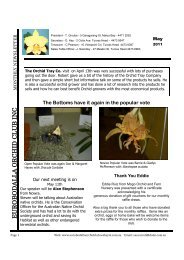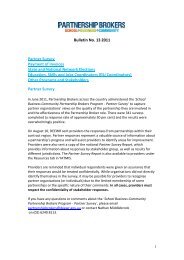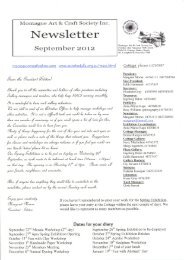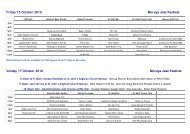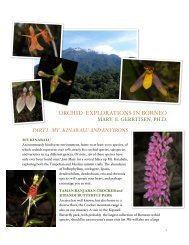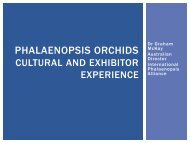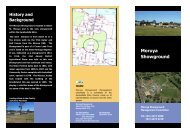Orchid Growing Substrates
Orchid Growing Substrates
Orchid Growing Substrates
You also want an ePaper? Increase the reach of your titles
YUMPU automatically turns print PDFs into web optimized ePapers that Google loves.
Some will just collapse and be converted to dust, like some originating from PR of China, while others<br />
will release a lot of sodium. Whilst on the paper it seemed promising, it did not have the commercial<br />
success expected. Like most of the other aggregates named here too, it is mined from some areas,<br />
and a specific type may well exist only in a few locations in the world, in small amounts only. It is not a<br />
renewable resource, like most of those stone products, but in this case, there are too many different<br />
diatomite, and variations of diatomite, to safely recommend it. It gave good results with<br />
phragmipedium according to some US reports. Diatomite is usually highly abrasive too, which can<br />
eventually hurt new root tips of Paphiopedilum.<br />
- There have been many claims that perlite contains very toxic levels of fluoride. However, in this case<br />
there is fluor present in many samples of perlite, on a purely analytical level, but most of the fluor<br />
atoms are included in molecules not likely to dissolve or be available to the plants anytime soon.<br />
Truly, there are other compounds in some perlite types, aluminum, chromium, nickel, sodium even,<br />
that will be slowly released when the perlite starts to degrade and that were more likely to be the<br />
culprit of some phytotoxicity outbreaks than fluor. The very coarse grade of perlite are a mystery, as<br />
they are highly sought after, and very rare in Europe, but they do not differ from pumice in their<br />
properties except that all types of perlite tends to crush easily over pressure, sometimes even they<br />
‘decompose’ for some sources, where pumice does not crush easily, and is much cheaper. Perlite<br />
needs to be de-dusted, and usually a grower will do it in two steps. The first, open the bag, and his<br />
lungs will filter the first part of the dust and then dump it in a bucket of water, with his lungs still<br />
taking full strength dust. In the second step, the perlite is soaked, and the dust falling to the bottom is<br />
removed, the supernatant kept for use ‘de-dusted’. Unless it is dried and stored again, where at that<br />
point it will start making dust again by friction.<br />
- Vermiculite is of no practical use to our minds. It is a laminated kind of material, which tends to<br />
decompose and clog after a while, leaving a lot of tiny plates. It will become too compact after a<br />
while, and it sometimes contains phytotoxic levels of aluminum. Some vermiculite tends to become<br />
extremely acid over time as well.<br />
Plastics<br />
There is a wide variety of plastics compounds. Overall, some are good ingredients, but none can be used<br />
alone.<br />
Tyres.<br />
o<br />
Starting with the funniest, shredder tyres. It has been popularized in the 90’s as a very cheap<br />
and ‘green’ potting material, recycling old tyres. Without going to the joke to know if the<br />
grower had a Goodyear with the plants repotted in it, it has been a failure. First, tyres can<br />
have incrustations of a lot of things, including oil, petroleum, whatever wheels travelled on.<br />
Second there are many compositions for the tyres, including as well some heavy metals,<br />
namely copper, to prevent their degradation. They are released in the potting mix after a<br />
Xavier Garreau de Loubresse<br />
10



